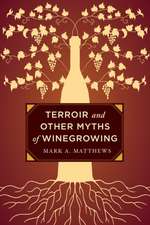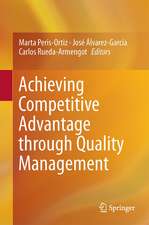Wine and Tourism: A Strategic Segment for Sustainable Economic Development
Editat de Marta Peris-Ortiz, María de la Cruz Del Río Rama, Carlos Rueda-Armengoten Limba Engleză Hardback – 8 dec 2015
Wine tourism, which combines two important yet distinct economic activities (i.e., tourism and viticulture), has recently emerged as a new tourism product driven by tourists’ search for new experiences and wineries’ need to diversify their businesses and seek new revenue streams to boost sales. This new form of tourism, which typically takes place in rural areas and which combines wine production with tourist activities, is becoming important for such regions by providing a complementary income source. It provides a model for sustainable economic development for these regions, which for various reasons may otherwise struggle to develop.
Featuring cases and business implications from various locations, this book provides an important source of knowledge—both theoretical and practical—suitable to academics, scholars, researchers, and practitioners in the tourism sector and the wine industry.
| Toate formatele și edițiile | Preț | Express |
|---|---|---|
| Paperback (1) | 640.24 lei 43-57 zile | |
| Springer International Publishing – 28 mar 2019 | 640.24 lei 43-57 zile | |
| Hardback (1) | 646.43 lei 43-57 zile | |
| Springer International Publishing – 8 dec 2015 | 646.43 lei 43-57 zile |
Preț: 646.43 lei
Preț vechi: 760.50 lei
-15% Nou
Puncte Express: 970
Preț estimativ în valută:
123.69€ • 129.49$ • 102.35£
123.69€ • 129.49$ • 102.35£
Carte tipărită la comandă
Livrare economică 07-21 aprilie
Preluare comenzi: 021 569.72.76
Specificații
ISBN-13: 9783319188560
ISBN-10: 3319188569
Pagini: 142
Ilustrații: XII, 279 p. 64 illus., 60 illus. in color.
Dimensiuni: 155 x 235 x 22 mm
Greutate: 0.59 kg
Ediția:1st ed. 2016
Editura: Springer International Publishing
Colecția Springer
Locul publicării:Cham, Switzerland
ISBN-10: 3319188569
Pagini: 142
Ilustrații: XII, 279 p. 64 illus., 60 illus. in color.
Dimensiuni: 155 x 235 x 22 mm
Greutate: 0.59 kg
Ediția:1st ed. 2016
Editura: Springer International Publishing
Colecția Springer
Locul publicării:Cham, Switzerland
Public țintă
ResearchCuprins
Chapter 1 Level of Implementation of Quality in the Designation of Origin and Monterrei Wine Route (Galicia- Spain).- Chapter 2 Quality of Landscape and Sustainability Benefit to Wine Tourism. Contexts and Commitments.- Chapter 3 Wine Tourism and Regional Development.- Chapter 4 Wine Routes and Territorial Events as Enhancers of Tourism Experiences.- Chapter 5 Monterrei Wine Tourist Route (Galicia- Spain): Analysis from the Perspective of Offer.- .- Chapter 6 The Experience of Wine Tourism in Vale dos Vinhedos - Rio Grande Do Sul – Brazil.- Chapter 7 Hotel Ships on the Douro River and their Relationship with the Terroir.- Chapter 8 The Wine Routes of Spain Products Club: The Case of the Ribera of Guadiana Wine Route (Spain).- Chapter 9 Complementarity and Interaction of Tourist Services in an Excellent Wine Tourism Destination: The Douro Valley (Portugal).- Chapter 10 Purchasing and Use Behaviour of the Wine Tourist on the Setúbal Peninsula Wine Route.- Chapter 11 The Wine-Growing Thematic and Cultural Festivities of the Grape and Wine Region, as Well as the Wine-Touristic Cluster’s Development of Serra Gaucha in Rio Grande do Sul (Brazil).- Chapter 12.- Wine Tourism and Gastronomy.- Chapter 13 Gastronomy and Wines in the Alentejo Portuguese Region: Motivation and Satisfaction of Tourists from Évora.- Chapter 14 High Altitude fine Wines from the Midwest Region of Santa Catarina (Brazil): An Wine Tourism Destination?.- Chapter 15 New World Labels for Old World Tradition.- Chapter 16 Wine Tourism Moving Towards Sustainable Viticulture? Challenges, Opportunities and Tools to Internalize Sustainable Principles in the Wine Sector.- Chapter 17 Google Search Activity as Thermometer of Wine Cellar Visitors.- Chapter 18 Literature Review of Wine Tourism Research: Bibliometric Analysis (1984-2014).
Textul de pe ultima copertă
The aim of this book is to show how wine tourism can be used as a model for sustainable economic development, driving economic growth and social development in some locations. It will explore the interaction between tourism and viticulture in wine tourism destinations, while also explaining some of the repercussions of these activities. This book covers various topics including regional development, environmental management, sustainable viticulture, quality management in wineries and wine tourism routes among others.
Wine tourism, which combines two important yet distinct economic activities (i.e., tourism and viticulture), has recently emerged as a new tourism product driven by tourists’ search for new experiences and wineries’ need to diversify their businesses and seek new revenue streams to boost sales. This new form of tourism, which typically takes place in rural areas and which combines wine production with tourist activities, is becoming important for such regions by providing a complementary income source. It provides a model for sustainable economic development for these regions, which for various reasons may otherwise struggle to develop.
Featuring cases and business implications from various locations, this book provides an important source of knowledge—both theoretical and practical—suitable to academics, scholars, researchers, and practitioners in the tourism sector and the wine industry.
Wine tourism, which combines two important yet distinct economic activities (i.e., tourism and viticulture), has recently emerged as a new tourism product driven by tourists’ search for new experiences and wineries’ need to diversify their businesses and seek new revenue streams to boost sales. This new form of tourism, which typically takes place in rural areas and which combines wine production with tourist activities, is becoming important for such regions by providing a complementary income source. It provides a model for sustainable economic development for these regions, which for various reasons may otherwise struggle to develop.
Featuring cases and business implications from various locations, this book provides an important source of knowledge—both theoretical and practical—suitable to academics, scholars, researchers, and practitioners in the tourism sector and the wine industry.
Caracteristici
Examines wine tourism as a model for sustainable economic development, economic growth and social development Examines various wine routes and their impact on regional, economic and social development Covers topics such as regional development, environmental management, and quality management

















